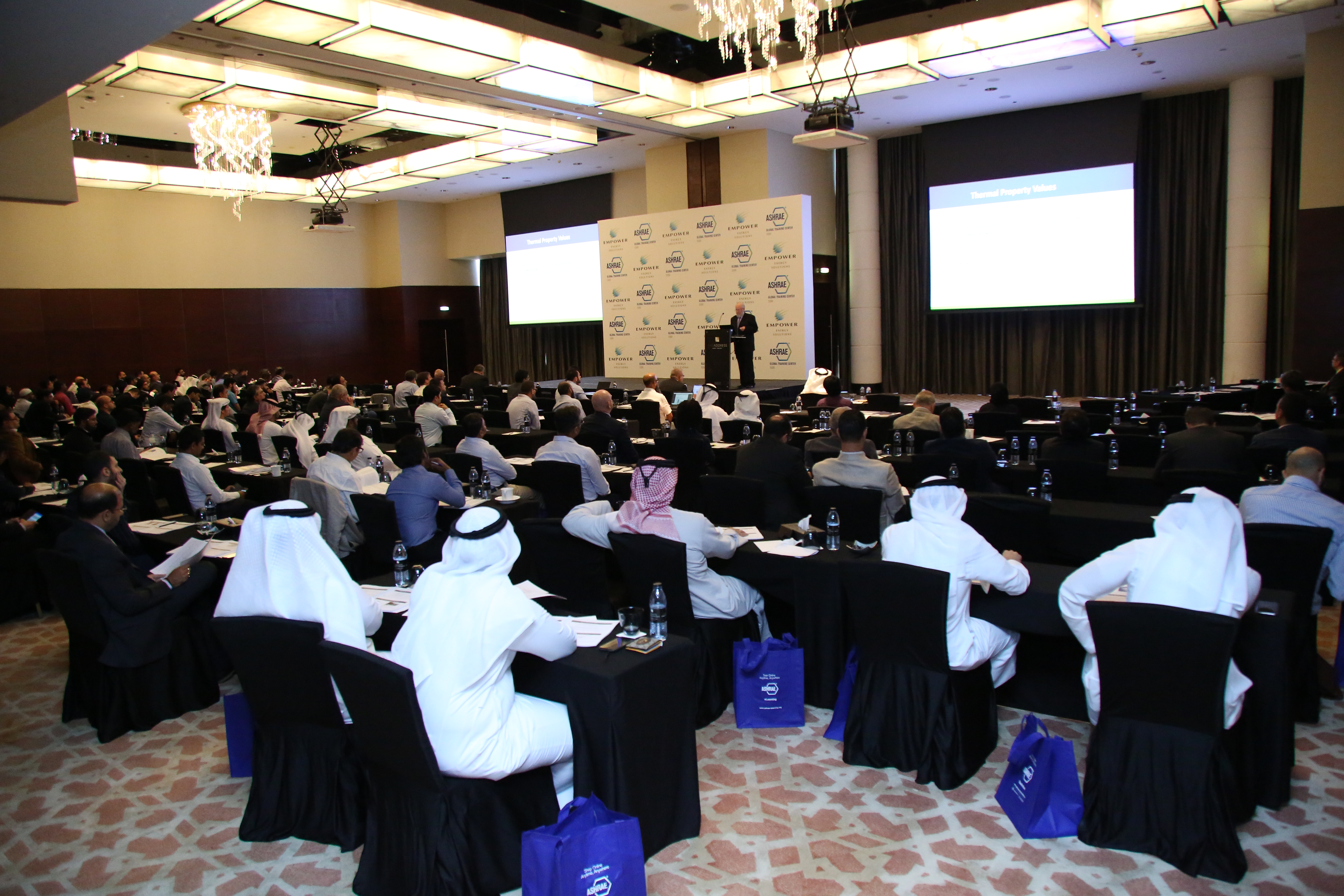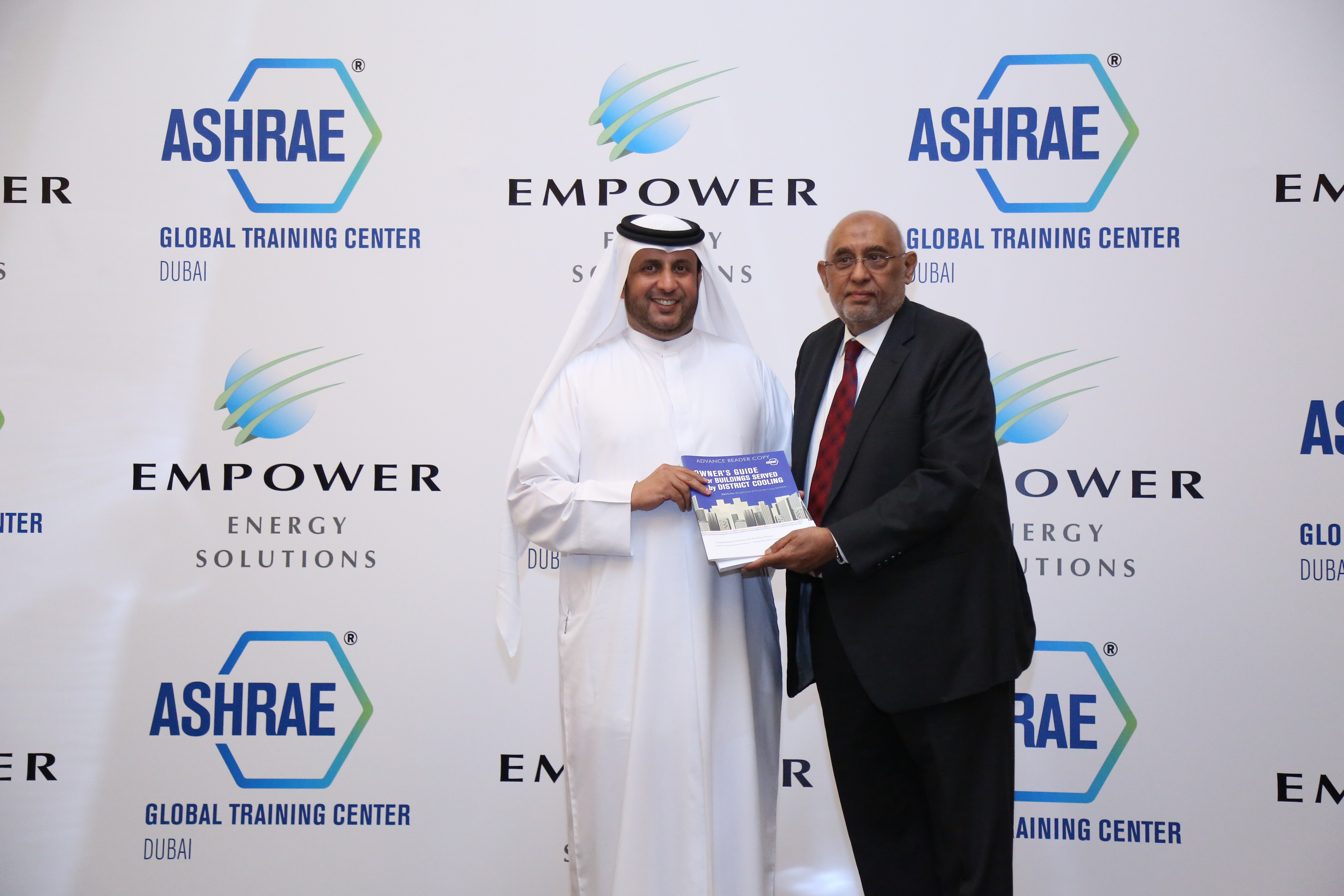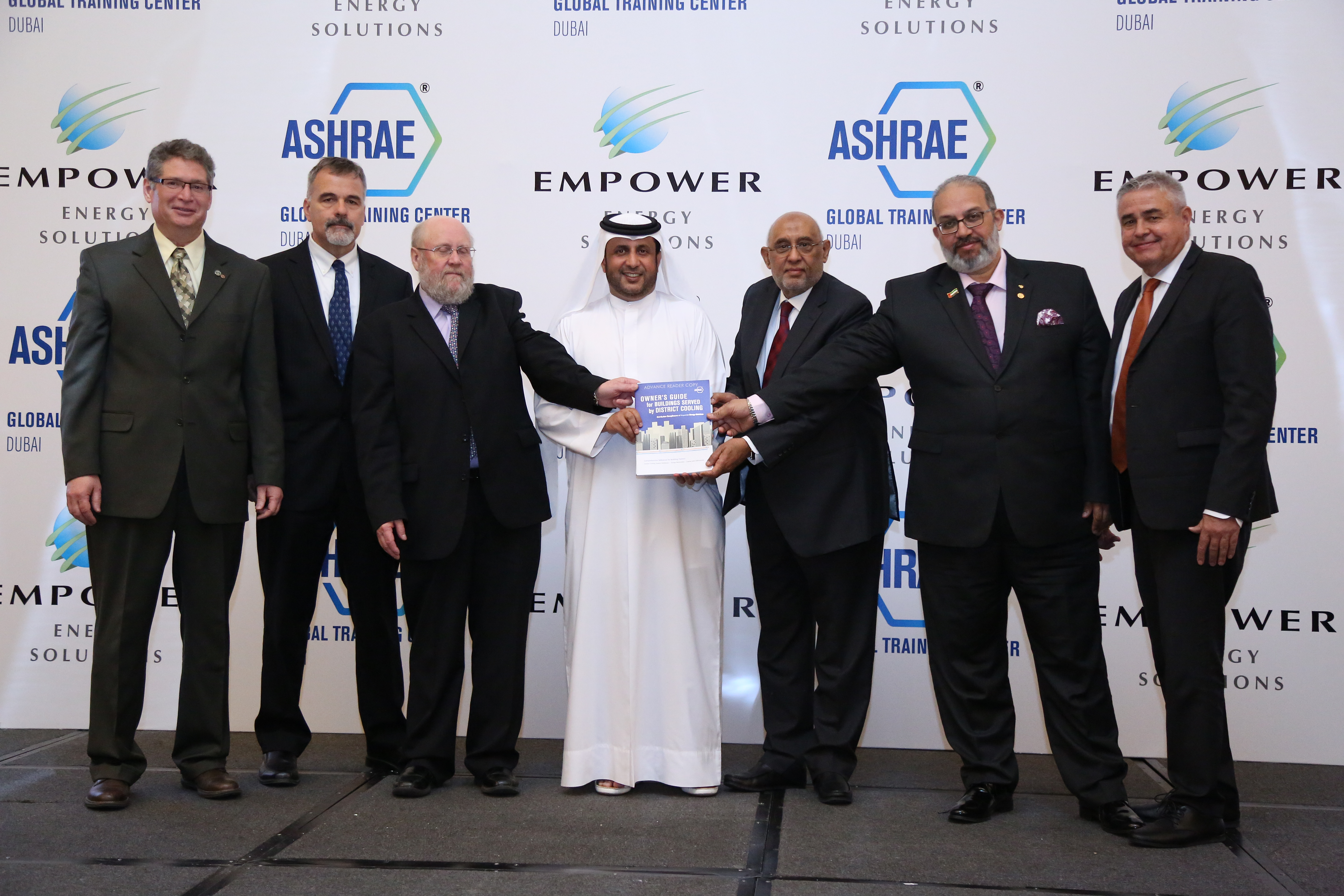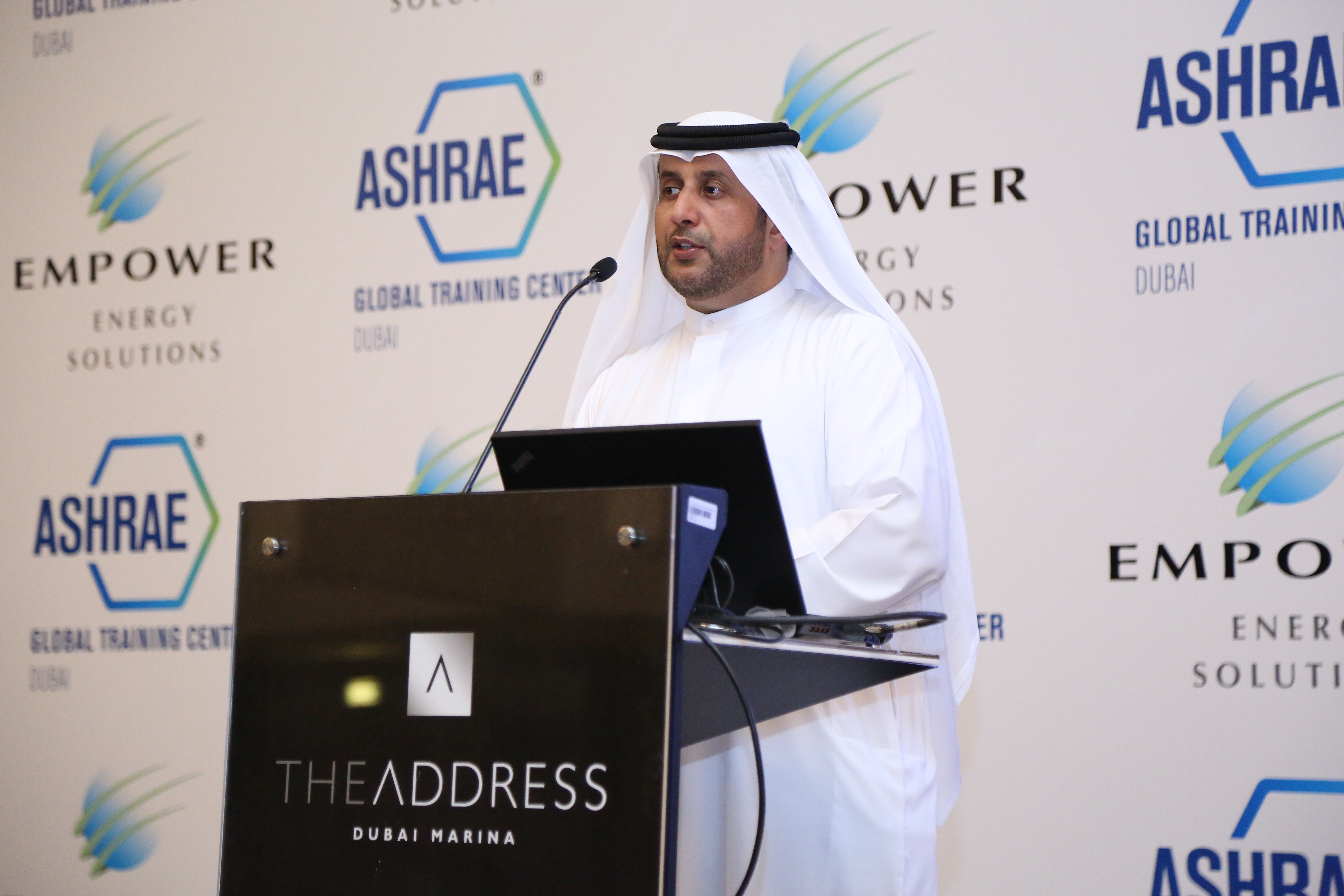Unlocking the Possibilities of District Cooling
ASHRAE and Empower Deliver District Cooling Guidance at Dubai Workshop; Two New Publications Launched
By WS Comstock, Contributing Editor, Europe & Middle East
From HVAC&R Industry, April 25, 2019
DUBAI, UNITED ARAB EMIRATES—District cooling has the potential to provide a sustainable solution to meet cooling requirements in the Middle East. District cooling can be more reliable, be more energy efficient, and has less negative environmental impact in the region than standard approaches to air conditioning.
To improve the design and effective use of district cooling systems, ASHRAE and Empower Energy Solutions teamed to present a full-day workshop in Dubai that attracted some 150 building cooling practitioners and suppliers. The workshop was organized by ASHRAE’s Global Training Center located there.
 About 150 building cooling practitioners and suppliers attended a workshop in Dubai with the
About 150 building cooling practitioners and suppliers attended a workshop in Dubai with the
goal of improving the design and effective use of district cooling systems.
Ahmad Bin Shafar, CEO of Emirates Central Cooling Systems Corporation (Empower), the world's largest district cooling services provider, stressed that Empower will continue its pioneering role in the district cooling sector and its efforts to transform Dubai into a global hub for clean energy and green economy. Dubai was named as the ‘Champion City’ for district cooling globally at the 2018 International District Energy Association (IDEA) District Cooling Conference and Tradeshow, showcasing a cooling capacity of about two million tons of refrigeration.
“We are very happy and proud that Dubai was selected to launch the ‘Owner’s Guide for Buildings Served by District Cooling’ and the updated edition of the ‘District Cooling Guide’ by ASHRAE. This allows us to renew our commitment to the role we play in consolidating Dubai's global position in the field of district cooling, and the energy sector, in general,” said Bin Shafar.
In a workshop ceremony during which copies of the publications were presented to Bin Shafar, ASHRAE Vice President Farooq Mehboob cited the Society’s long-standing cooperation with Empower. “The far-sighted leadership of HE Ahmad Bin Shafar has helped to establish Dubai as a hub for technology,” said Mehboob. “Dubai’s strong reputation for innovation is one reason why ASHRAE established its first Global Training Center here.”
District cooling systems can provide buildings in the serviced area with distributed chilled water for comfort and process cooling with the benefits to the building owner of greatly reduced or eliminated maintenance cost, much lower space requirements, and no concerns as to plant capacity or load growth.
“As the new books explain, district cooling systems, when designed and operated properly, can be an energy-efficient alternative to conventional in-building chilled water plant adding to an owner’s sustainability portfolio. They allow building owners to focus on their own business, rather than operating and maintaining a chilled water plant,” said Dr. Ahmed Alaa, chair of the ASHRAE region that coordinates ASHRAE activities in the part of the world that includes the Middle East.


Left: Ahmad Bin Shafar, CEO of Emirates Central Cooling Systems Corporation (Empower), left, and Farooq Mehboob, ASHRAE Vice President, right, hold a copy of ASHRAE's "Owner’s Guide for Buildings Served by District Cooling." Right: ASHRAE instructors Steve Tredinnick; Brian Kirk and Gary Phetteplace; Ahmad Bin Shafar, CEO of Emirates Central Cooling Systems Corporation (Empower); Farooq Mehboob, ASHRAE Vice President; Dr. Ahmed Alaa, ASHRAE Region-at-Large Director and Regional Chair; and Steve Comstock. pose with a copy of ASHRAE's "Owner’s Guide for Buildings Served by District Cooling" at the workshop.
Three of the authors of the new ASHRAE guides, all ASHRAE members, traveled from the U.S. to instruct the workshop. Gary Phetteplace provided an overview of district cooling technology, planning, and distribution system design and thermal energy storage considerations. Brian Kirk focused on operations and maintenance. Steve Tredinnick addressed central plant design, building interface and building equipment design.
The “Owner’s Guide for Buildings Served by District Cooling” is a useful reference for building owners and designers, providing them with basic information on the advantages of district cooling services and the installation and operation of cooling systems in a simple manner. The guide addresses owners' concerns, such as selection of the design consultant, responsibilities for the maintenance of equipment within buildings, and the tariff structures for district cooling services, and in addition provides building designers with guidance on the consumer interconnection at the building, in building equipment design for DC service and maintenance. The guide also reviews dealing with design flaws and other system constraints found in existing buildings. Two appendices provide an analysis of the efficiency robbing "low delta T syndrome" on chiller plant performance and a case study on correcting low delta T in an existing building.
The updated edition of the “District Cooling Guide” provides design guidance on all aspects of DC system design and includes a chapter dedicated to the planning process. It offers information on how to improve cooling systems and incorporate the concept of thermal storage into a district cooling system. The manual also gives guidance on operational and maintenance processes to help operators ensure that systems work as intended. Also included are thorough case studies of a diverse sample of existing systems. The guide will be a valuable reference for both designers who do not have experience in district cooling, as well as specialist consultants, utility engineers, cooling system engineers, central plant design engineers and chilled water system designers.
According to the new ASHRAE publications, generating chilled water in a central plant is normally more efficient than using in-building equipment, normally reducing the environmental impacts. The greater efficiencies arise primarily due to the larger, more efficient equipment and the ability to stage that equipment to closely match the load yet remain within the equipment’s range of highest efficiency.
District cooling systems may take advantage of demand diversity across all users in the system and may also implement technologies such as thermal storage more readily than individual building cooling systems. For electric-driven district cooling plants, higher efficiency becomes the central environmental benefit since in-building plants are normally electric driven as well.


Left: ASHRAE instructor Gary Phetteplace speaks during the workshop. Three of the authors, including Phetteplace, of the new ASHRAE district cooling guides, all ASHRAE members, traveled from the U.S. to instruct the workshop. Right: Ahmad Bin Shafar, CEO of Emirates Central Cooling Systems Corporation (Empower), addresses the workshop's attendees. ASHRAE and Empower Energy Solutions presented the workshop together.
There also can be environmental benefits from cooling supplied from a large central plant, such as the ability to use treated sewage effluent as cooling tower makeup water, options that would not be feasible for in-building systems. Other environmental advantages may come from the ability to use sea water or fresh surface water for heat rejection directly—again, an option that is likely not feasible on a single building scale. Furthermore, in some instances, deep sea water or deep fresh surface water may be cold enough to provide cooling directly without the use of refrigeration equipment.
Environmental benefits will normally also be realized because of the increased efficiency that comes with vigilant maintenance and operational optimization realized when the cooling source is operated as a business itself rather than an often neglected and minor ancillary to the core business.
The ability to handle refrigerants in a safer and more controlled environment is yet another major environmental advantage of district cooling systems. Beginning with the Montreal Protocol in 1987, refrigeration working fluids have since been in a constant state of flux due to the preponderance of equipment already in use as well as the lack of readily available alternatives. Phaseout of the most harmful compounds has largely been by replacement, using less harmful, but by no means harmless, refrigerants. Refrigerants and other chemicals can be monitored and controlled more readily in a central plant. Where site conditions allow, remote location of the plant reduces many of the concerns with the use of ammonia systems for cooling.
The workshop taught attendees how to:
- Grasp the fundamental processes and equipment of the DCS central plant and the basic options;
- Gain a basic understanding of the issues regarding plant economic analysis;
- Appreciate the complexity of the planning process and the players that must be involved for success;
- Know the basic construction materials for chilled water distribution systems;
- Learn the important factors for building owners to understand when considering district cooling to serve their buildings;
- Understand the basic methods in which a building may interface with the district cooling system;
- Know what provisions must be made for a successful interface of the HVAC equipment of the building with the district cooling system;
- Review how “Low ΔT” may come about and what can be done to correct it;
- Understand the basics of thermal energy storage for district cooling systems;
- Appreciate the O&M basics for district cooling systems.
The new publications, available in June, can be pre-ordered together here. The guides can be purchased in printed edition or PDF for $169. The guides can be purchased in both formats for $245.
The workshop will be repeated in other cities globally where district cooling is a viable design option. For more information about future workshops contact Karen Murray, ASHRAE manager of professional development (kmurray@ashrae.org).
Empower provides district cooling services to more than 1,090 buildings, catering to more than 100,000 customers. The company operates more than 1.43 Million Refrigeration Tons (RT), providing environmentally friendly district cooling services to large-scale real estate developments, such as Bluewaters, Jumeirah Group, Business Bay, Jumeirah Beach Residence, Dubai International Financial Centre, Palm Jumeirah, Jumeirah Lake Towers, Ibn Battuta Mall, Discovery Gardens, Dubai Healthcare City, Dubai World Trade Centre Residences and Dubai Design District, International Media Production Zone and others.